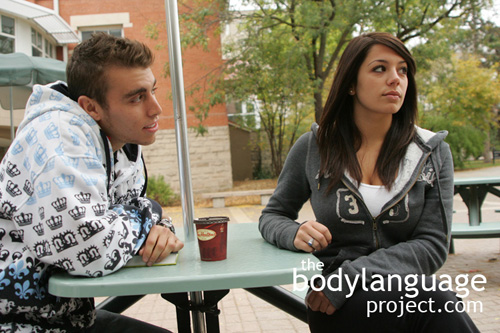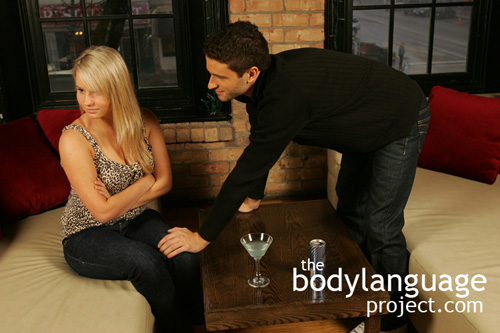Body Language of Lip Chewing or Chewing The Lips
 Cue: Lip Chewing or Chewing The Lips
Cue: Lip Chewing or Chewing The Lips
Synonym(s): Chewing The Lips, Biting The Lip, Lip Nibble, Cheek Biting, Lip-to-Lip Bite, Lip Chewing.
Description: a) The lower or upper lip is bitten. b) The lips are brought tightly together against the teeth as if the lips are biting each other in a lip-to-lip bite. It is visible as the lips come inward slightly. c) The teeth bite the insides of the cheeks or the corner of the mouth visible as the mouth is contorted sideways to bring the cheek toward the teeth. The lips may purse and also bounce up and down as if chewing food.
In One Sentence: Lip chewing is a negative thought indicator.
How To Use it: One should avoid chewing on the lips as it tells others that you are suffering from negative internal emotions. Feigning or actual negative emotions, on the other hand, can incentivize others to offer care and support. Therefore, the signal has applications as an honest gesture of suffering.
Context: General.
Verbal Translation: “I’m pacifying and punishing myself due to the negative thoughts and feelings I carry around with me.”
Variant: When pacifying is necessary, people find comfort in biting other objects such as pencils, their fingernails or the stems of their glasses. They may also pull and pinch at themselves. See Lip Biting or Biting The Lip, Lip Picking.
Cue In Action: She was on antidepressant medication and seeing a shrink but even in benign social situations, she would be found fretting as she chewed the insides of her cheeks.
Meaning and/or Motivation: Sucking, plucking, picking or chewing the lips, rubbing them with a finger or thumb are all forms of auto touching. Confident individuals would never consider using this type of behaviour out of insecurity.
When someone feels anxious they habitually find an outlet via chewing. Usually this is a pencil or pen, fingers or finger nails but when nothing else is available or as a default, the lips or sides of the mouth are chewed.
This is a subconscious return to the mouthing of a breast and reminds adults of the tactile pacifier which it served in infancy. The lips often serve as outlets for anxiety because they are always readily available unlike a pencil or other soother. Lip and cheek biting can also be a form of self-restraint, though usually not if it is done persistently, but rather suddenly in response to a certain message or stimuli. Alternatively, lip chewing can signify the desire to act out aggressively where the pain is turned inward rather than expressed outwardly.
Cue Cluster: When someone is anxious, expect their bodies to reflect a desire to turn inwards such as eyes turned downward and glazed over, head down and the shoulders slump. Emotional downtime, when people escape inward while in public, is characterized by pauses in breathing, subtle chewing of the lips, or very brief eye freezes or glazing over.
Body Language Category: Anxious body language, Clenching and gripping, Depressive body language, Energy Displacement, Frustration or frustrated body language, Hostile body language, Intention movements, Leaked or involuntary body language, Low confidence body language, Masked emotions, Microgestures, Negative body language, Nervous body language, Oral displacement activities, Pseudo-infantile gestures, Pacifying body language, Stressful body language, Threat displays.
Resources:
Breau, Lynn M. ; Camfield, Carol S. ; Symons, Frank J. ; Bodfish, James W. ; MacKay, Alison ; Finley, G.Allen ; McGrath, Patrick J. Relation between pain and self-injurious behavior in nonverbal children with severe cognitive impairments. The Journal of Pediatrics. 2003 142(5): 498-503.
Croyle, Kristin L. ; Waltz, Jennifer. Subclinical Self-Harm: Range of Behaviors, Extent, and Associated Characteristics. American Journal of Orthopsychiatry. 2007. 77(2): 332-342.
Colville, G A; Mok, Q. Psychological management of two cases of self injury on the paediatric intensive care unit. Archives of Disease in Childhood. 2003. 88(4): 335.
Christenson, Gary A. ; Mackenzie, Thomas B. ; Mitchell, James E. Characteristics of 60 adult chronic hair pullers. American Journal of Psychiatry. 1991. 148(3): 365(6).
Feteih RM: Signs and Symptoms of Temporomandibular Disorders and Oral Parafunctions in Urban Saudi Arabian Adolescents: A Research Report. Head Face Med. 2006. 2: 25.
Ghanizadeh, Ahmad and Hajar Shekoohi. Prevalence of Nail Biting and its Association With Mental Health in a Community Sample of Children. BMC Research Notes. 4 (Apr. 11, 2011): p116. DOI: http://dx.doi.org/10.1186/1756-0500-4-116.
http://bodylanguageproject.com/articles/body-language-nail-biting/
Gavish A, Halachmi M, Winocur E, Gazit E: Oral Habits and Their Association With Signs and Symptoms of Temporomandibular Disorders in Adolescent Girls. Journal of Oral Rehabilation. 2000, 27(1): 22-32.
Ghanizadeh A: Association of Nail Biting and Psychiatric Disorders in Children and Their Parents in a Psychiatrically Referred Sample of Children. Child Adolescents
Psychiatry Mental Health. 2008. 2(1):13.
Ghanizadeh, Ahmad. Association of nail biting and psychiatric disorders in children and their parents in a psychiatrically referred sample of children.(Research)(Clinical report). Child and Adolescent Psychiatry and Mental Health. 2008. 2(13): 13.
Harriss, Louise ; Hawton, Keith. Deliberate self-harm in rural and urban regions: A comparative study of prevalence and patient characteristics. Social Science & Medicine. 2011. 73(2): 274-281.
Garnefski N 2004) Cognitive emotion regulation strategies and depressive symptoms: differences between males and female. Personal Indiv Diff 36: 267–76.
Huflejt-Łukasik M, Czarnota-Bojarska J (2006) Short Communication: Selffocused attention and self-monitoring influence on health and coping with stress. Stress Health 22: 153–59.
Jaquier, Véronique ; Hellmuth, Julianne C. ; Sullivan, Tami P.. Posttraumatic stress and depression symptoms as correlates of deliberate self-harm among community women experiencing intimate partnerviolence. Psychiatry Research. 2013. 206(1): 37-42.
Jacobson, Colleenm. ; Muehlenkamp, Jenniferj. ; Miller, Alecl. ; Turner, J. Blake. Psychiatric Impairment Among Adolescents Engaging in Different Types of Deliberate Self-Harm. Journal of Clinical Child & Adolescent Psychology. 2008. 37(2): 363-375.
Katza, Carmit; Irit Hershkowitz; Lindsay C. Malloya; Michael E. Lamba; Armita Atabakia and Sabine Spindlera. Non-Verbal Behavior of Children Who Disclose or do not Disclose Child Abuse in Investigative Interviews. Child Abuse & Neglect. 2012. 36: 12-20.
http://bodylanguageproject.com/articles/reading-nonverbal-behaviour-child-abuse-cases-encourage-children-divulge-information-truth-telling
Kravitz, Harvey. Lip biting in infancy. The Journal of Pediatrics. 1964. 65(1): 136-138.
Laye – Gindhu, Aviva ; Schonert – Reichl, Kimberly A.. Nonsuicidal Self-Harm among Community Adolescents: Understanding the “Whats” and “Whys” of Self-Harm. Journal of Youth and Adolescence. 2005. 34(5): 447-457.
Lyon, Lionel Sasson. A behavioral treatment of compulsive lip-biting. Journal of Behavior Therapy and Experimental Psychiatry. 1983. 14(3): 275-276.
Mohiyeddini, C., Bauer, S., & Semple, S. (2013a). Displacement behaviour is associated with reduced stress levels among men but not women. PLoS One, 8, e56355.
Mohiyeddini, C., Bauer, S., & Semple, S. (2013b). Public self-consciousness moderates the link between displacement behaviour and experience of stress in women. Stress, 16, 384–392.
Mohiyeddini, C., & Semple, S. (2013). Displacement behaviour regulates the experience of stress in men. Stress, 16, 163–171.
Nolen-Hoeksema S, Aldao A (2011) Gender and age differences in emotion regulation strategies and their relationship to depressive symptoms. Personal Indiv Diff 51: 704–8.
Navarro, Joe. 2008. What Every BODY is Saying: An Ex-FBI Agent’s Guide to Speed-Reading People. William Morrow Paperbacks.
Nock, Matthew K. Actions speak louder than words: An elaborated theoretical model of the social functions of self-injury and other harmful behaviors. Applied and Preventive Psychology. 2008. 12(4): 159-168.
Pelc AW, Jaworek AK: Interdisciplinary Approach to Onychophagia. Przegl Lek. 2003. 60(11): 737-739.
Ross, Shana ; Heath, Nancy. A Study of the Frequency of Self-Mutilation in a Community Sample of Adolescents. Journal of Youth and Adolescence. 2002. 31(1):.67-77.
Seekles, Wike ; van Straten, Annemieke ; Beekman, Aartjan ; van Marwijk, Harm ; Cuijpers, Pim. Effectiveness of guided self-help for depression and anxiety disorders in primary care: A pragmatic randomized controlled trial. Psychiatry Research. 2011. 187(1): 113-120.
Straker, Gillian. Signing with a Scar: Understanding Self-Harm. Psychoanalytic Dialogues. 2006. 16(1): 93-112
Sturman, Edward D. Invluntary Subordination and Its Relation to Personality, Mood,
and Submissive Behavior. Psychological Assessment. 2011. 23(1): 262-276 DOI: 10.1037/a0021499
http://bodylanguageproject.com/articles/nonverbal-submission-men-women-depression-critical-examination-use-disuse-submission/
Tanaka OM, Vitral RW, Tanaka GY, Guerrero AP, Camargo ES: Nailbiting, or Onychophagia: A Special Habit. American Journal of Orthod Dentofacial Orthop. 2008. 134(2): 305-308.
Tamres L, Janicki D, Helgeson VS (2002) Sex differences in coping behaviour: a meta-analytic review. Personal Soc Psychol Rev 6: 2–30.
Troisi A (2002) Displacement activities as a behavioural measure of stress in nonhuman primates and human subjects. Stress 5: 47–54.
Troisi A (1999) Ethological research in clinical psychiatry: the study of nonverbal behaviour during interviews. Neurosci Biobehav Rev 23: 905–913.
Troisi A, Moles A (1999) Gender differences in depression: an ethological study of nonverbal behaviour during interviews. J Psychiatr Res 33: 243–250.
Tamres L, Janicki D, Helgeson VS (2002) Sex differences in coping behaviour: a meta-analytic review. Personal Soc Psychol Rev 6: 2–30.
Tureck, Kim ; Matson, Johnny L. ; Beighley, Jennifer S. An investigation of self-injurious behaviors in adults with severe intellectual disabilities. Research in Developmental Disabilities. 2013. 34(9): 2469-2474.
von Hippel W, von Hippel C, Conway L, Preacher KJ, Schooler JW, et al. (2005) Coping with stereotype threat: denial as an impression management strategy. J Personal Soc Psychol 89: 22–35.








